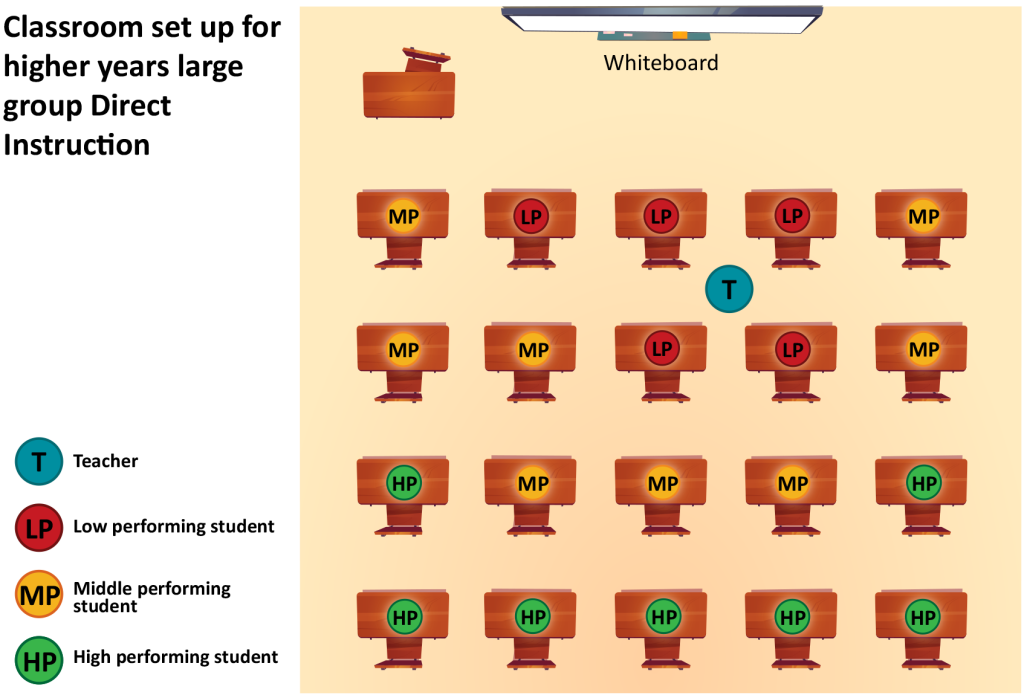Teach Reading Mastery Transformations Years 4 and 5
-
Module Introduction5 Topics
-
Overview13 Topics|2 Tests
-
Cover
-
Lesson Objective
-
Opening the Lesson
-
Direct Instruction Overview
-
Core Features of RMT 4-5
-
Video: RMT 4-5 Videos on Informational and Narrative Text
-
Who the Program is Intended for and Time Requirements
-
RMT 4-5 Teacher and Student Materials
-
Check Your Understanding
-
Teacher’s Guide
-
Test Your Understanding
-
Review
-
Lesson Completed
-
Cover
-
Setting up for Success24 Topics|3 Tests
-
Cover
-
Lesson Objective
-
Opening the Lesson
-
Placement Test Overview
-
Placement Test Guidelines
-
Placement Test Directions
-
Placement Test
-
Grouping and Classroom Arrangement
-
Check Your Understanding
-
Using a Script
-
Group Displays
-
Online Teacher’s Course
-
Signals
-
Signal Specifics
-
Video: Auditory Signal
-
Pacing
-
Check Your Understanding
-
Teaching to Mastery
-
Error Correction Procedures
-
RMT 4 Lesson 2, Exercise 3 Correction Procedure
-
Error Correction Practise
-
Test Your Understanding
-
Review
-
Lesson Completed!
-
Cover
-
Word Practice and Vocabulary Definitions18 Topics|4 Tests
-
Cover
-
Lesson Objective
-
Opening the Lesson
-
Word Practice
-
Individual Turns
-
Teaching Word Practice and Individual Turns
-
Check Your Understanding
-
Vocabulary Words
-
Video: Vocabulary
-
Teaching Vocabulary
-
Check Your Understanding
-
Word Practice Correction Procedures
-
Vocabulary Correction Procedures
-
Video
-
Check Your Understanding
-
Test Your Understanding
-
Review
-
Lesson Completed!
-
Cover
-
Story Selections and Comprehension17 Topics|4 Tests
-
Cover
-
Lesson Objective
-
Opening the Lesson
-
Group Oral Reading
-
Presenting Oral Reading Exercises
-
Check Your Understanding
-
Story Reading Correction Procedures
-
Story Reading Correction
-
Silent Reading
-
Check Your Understanding
-
Presenting Comprehension Questions
-
Comprehension Questions
-
Comprehension Correction Procedures
-
Check Your Understanding
-
Test Your Understanding
-
Review
-
Lesson Completed!
-
Cover
-
Writing Assignments, Paired Practice and Fact Games17 Topics|3 Tests
-
Cover
-
Lesson Objective
-
Opening the Lesson
-
Writing Assignments
-
Writing Assignments (Continued)
-
Writing Assignment Teaching Suggestions
-
Video: Writing Assignment
-
Check Your Understanding
-
Paired Practice
-
Paired Practice Teaching Suggestions
-
Implementing Paired Practice
-
Decoding Support
-
Check Your Understanding
-
Fact Games
-
Test Your Understanding
-
Review
-
Lesson Completed!
-
Cover
-
Independent Work and Work Check16 Topics|3 Tests
-
Cover
-
Lesson Objective
-
Opening the Lesson
-
Independent Work Overview
-
Independent Work Procedures
-
Teaching Suggestions for Independent Work
-
Check Your Understanding
-
Group Work Check
-
Group Work Check Procedures
-
Group Work Check
-
Check Your Understanding
-
Active Monitoring
-
Active Monitoring
-
Test Your Understanding
-
Review
-
Lesson Completed!
-
Cover
-
Mastery Tests and Fluency Checkouts20 Topics|3 Tests
-
Cover
-
Lesson Objective
-
Opening the Lesson
-
Mastery Tests Overview
-
Independent Work Components
-
Online Components for Administering Mastery Tests
-
Mastery Test: Creating an Assignment
-
Check Your Understanding
-
Mastery Test: Student Experience
-
Video: Mastery Test: Student Experience
-
Fluency Checkout Overview
-
Online Components for Fluency Checkouts
-
Video: Fluency Checkouts Video Using Online Tools
-
Completing Fluency Checkouts
-
Teaching Suggestions and Identifying Errors During Checkouts
-
Check Your Understanding
-
Video: A Teacher Administering a Fluency Checkout
-
Test Your Understanding
-
Review
-
Lesson Completed!
-
Cover
-
Remedy Lessons and Retesting16 Topics|3 Tests
-
Cover
-
Lesson Objective
-
Opening the Lesson
-
Passing Criteria for Fluency Checkouts
-
Passing Criteria for Mastery Tests
-
Check Your Understanding
-
Recording Mastery Test and Checkout Scores
-
Video: Remedy Lesson
-
Firming Students and Delayed Tests
-
Good-bye List
-
Video: Implementing a Good-bye List
-
Check Your Understanding
-
Reviewing Mastery Test and Checkout Data
-
Test Your Understanding
-
Review
-
Lesson Completed
-
Cover
-
Setting Expectations and Motivating Students25 Topics|3 Tests
-
Cover
-
Lesson Objective
-
Opening the Lesson
-
Setting Expectations and Motivating Students: Overview
-
Video: Teaching Rules and Routines
-
Providing Specific Praise
-
Motivating Students and Affirmations
-
Video: Teacher Using Affirmations
-
Check Your Understanding
-
Routines and Expectations
-
STAR Rules
-
Video: Teaching Routines
-
Implementing the Teacher-Student Game
-
Teacher-student Game Scenario
-
Celebrations and Rewards for Students
-
Video: Teacher-Student Game
-
Check Your Understanding
-
Transitions
-
Video: Transitions
-
Being Prepared
-
Pacing of the Lesson
-
Video: Responses Per Minute
-
Test Your Understanding
-
Review
-
Lesson Completed
-
Cover
-
Goal Setting and Tracking Student Progress18 Topics|3 Tests
-
Cover
-
Lesson Objective
-
Opening the Lesson
-
Goal Setting Overview
-
Story Reading Goals
-
Mastery Goals
-
Tracking Mastery During Lessons
-
Tracking Mastery Scenario
-
Video: Data Collection
-
Check Your Understanding
-
Lesson Progress Goals
-
Data Wall
-
Video: What is a Data Wall?
-
Check Your Understanding
-
Video: Tracking Progress Using a Data Wall
-
Test Your Understanding
-
Review
-
Lesson Completed
-
Cover
-
Teaching a Lesson from RMT 416 Topics
-
Cover
-
Lesson Objective
-
Opening the Lesson
-
Lesson 36, Exercise 1: Word Practise
-
Lesson 36, Exercise 2: Vocabulary Review
-
Lesson 36, Exercise 3: Vocabulary Words
-
Lesson 36, Exercise 4: Individual Turns
-
RMT 4 Lesson 36, Exercises 1-4
-
Correcting Errors
-
Lesson 36, Exercises 1-4 with Correcting Errors
-
Lesson 36, Exercise 5: Vocabulary Definitions
-
Lesson 36, Exercise 6: Hyphens
-
Lesson 36, Exercises 5 and 6 and Specific Praise
-
Lesson 35, Exercise 7: Reading Literature: Fable
-
Error Limit
-
Work Assignment and Word Check
-
Cover
-
Teaching a lesson from RMT 518 Topics|1 Test
-
Cover
-
Lesson Objective
-
Opening the Lesson
-
Lesson 4, Exercise 1: Compound Words
-
Lesson 4, Exercise 2: Names
-
Lesson 4, Exercise 3: Vocabulary Words
-
Exercise 4: Vocabulary Review
-
Lesson 4, Exercise 5: Individual Turns
-
RMT 5 Lesson 4, Exercises 1-5
-
Lesson 4, Exercise 6: Vocabulary Definitions
-
Lesson 4, Exercise 7: Deductions
-
Correcting Errors
-
Lesson 4, Exercises 6-7 with Correcting Errors
-
Lesson 4, Exercise 8, Reading Literature: Epic
-
Decoding Error Limit
-
Epic Reading, Picture Comprehension and Correcting eErors
-
Review
-
Lesson Completed
-
Cover
-
Module Evaluation Survey1 Topic
Participants 482
Grouping and Classroom Arrangement
ddewell@goodtogreatschools.org.au August 7, 2023

Grouping and Classroom Arrangement
RMT levels 4–5 can be taught to an entire class. Students are grouped homogeneously based on their placement test results using the placement guidelines on the previous page. For groups with higher-performing students, classes can have up to 20 students. For lower-performing students, it is recommended that groups are smaller to provide more individual attention (10 students or less).
The ideal classroom arrangement has students seated at desks, with desks placed in rows as shown in the diagram. There is room between desks for the teacher to circulate and monitor students as they work. Desks face the front of the classroom and the board where displays are shown. Students should not have to turn their head to see the front of the classroom or the displays.
Lowest performers are seated closest to the front-centre of the classroom. This gives the teacher close proximity to assist and monitor these students.
Middle performers are seated around the lower performers.
Higher performers are seated around the outside of the lower and middle performers. This arrangement allows for easy monitoring of all students in the classroom.


